I had two big deadlines this Friday for various projects, and I am happy to report that I made both of them. That means I finally have time to take a breath, and write the post you have all been waiting for. What happened at the U. S. Amateur Team East chess tournament!?
That's right! Over President's weekend I made my annual pilgrimage to Parsippany, NJ, to play in the biggest tournament of the year. With something like 1200 players, it's really just a big chess party. I don't play nearly as much tournament chess as I used to, but I definitely make an effort to come out of retirement for this one.
Of course, the chess itself is really of secondary interest. For me the highlight is the impromptu reunion of the old Princeton Chess Club:

Here we are having a lunch at a local diner before the first round. Starting from the left we have Matt Allman, who used to drive me to chess tournaments back in the days before I had a license. That's his son sitting next to him, but, alas, I didn't catch his name. The fellow too fascinated by the menu to look up is Jon Edwards, formerly the U. S. Correspondence Chess Champion and the author of many excellent chess books. Then we have Doug Proll and Ned Walthall. Ned founded the club way back in the eighties. How long have I been playing chess with these guys? Well, I was in middle school when the club started.
Joel Heinrich, a physicist at the University of Pennsylvania, was also there, but I couldn't fit everyone into the picture.
Of course, there was also chess. In the first round we got paired against a team representing West Windsor Plainsboro High School, North. That's right near where I grew up! Of course, when I was around there was no North and South. There was just one high school. The population of the area has grown a bit. Anyway, my opponent sported a rating of 1911, which is funny, since that is precisely my rating as well. Playing white, I employed the Bishop's Opening. We pick up the action as I'm about to play my 29th move:

That tripled pawn on the c-file was the result of one of my less brilliant plans about a dozen moves earlier. The position is very complex, but two features stick out. One is that black has a big trump in the form of his passed a-pawn. The second is that it's hard for white's bishop to find any activity. So I decided it was time to go for glory with 29. Bxc5!. The computer gives this move its seal of approval, and gives black only a very slight advantage after it. Play continued: 29. ... dxc5 30. Qxc5+ Kg8 31. Qxe5, leading to this position:
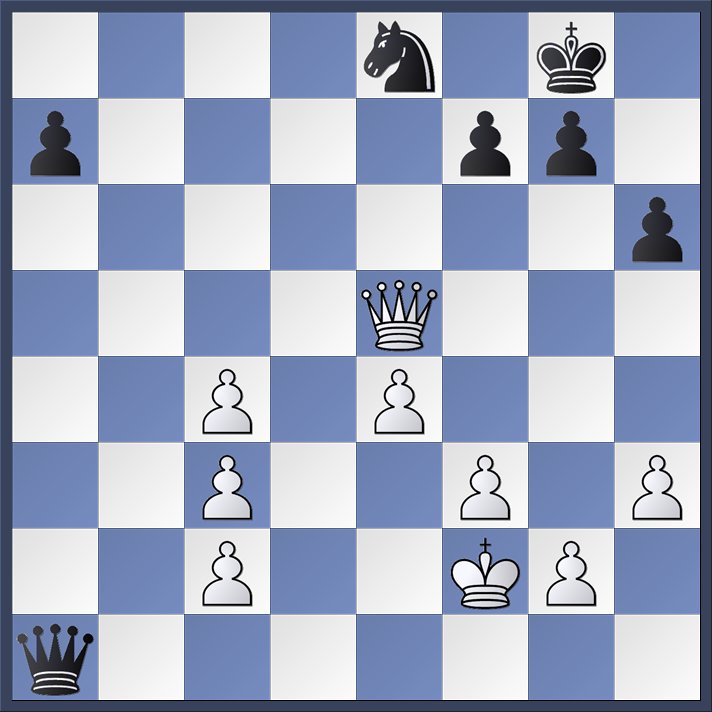
The smoke has cleared. The good news is that white has three pawns for his bishop. The bad news is that they are all on the c-file. Still, those are mobile passed pawns, and black's king is living in exile far from the action. The position is difficult. Going over the subsequent play with the computer reveals that we both made some mistakes, and black missed a couple of clear wins. For the record, here's the final position:
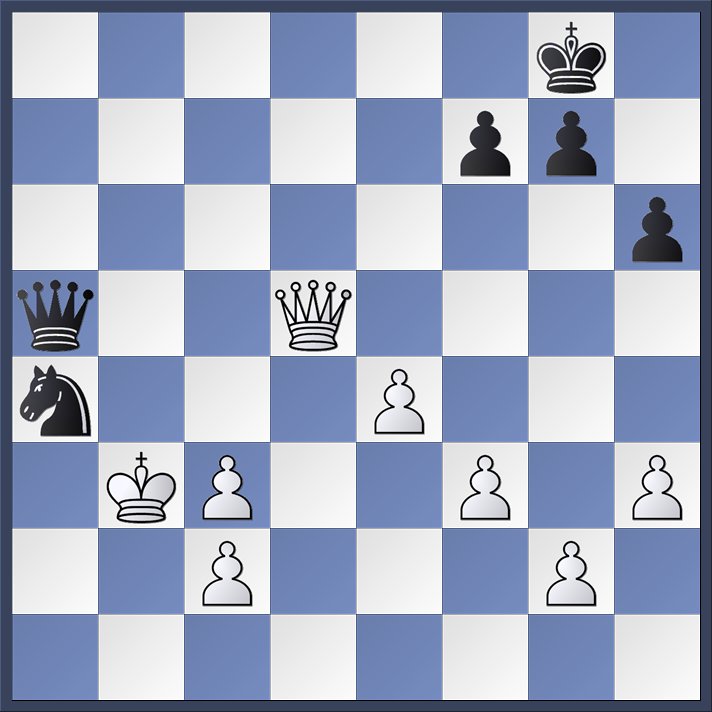
Black used his a-pawn as a decoy, allowing him to win the lead c-pawn (which had been marching down the board with determination and vigor). Black can still claim a small edge, but it is very difficult for him to make progress, since his king is awfully far from action. So my opponent offered a draw, which I accepted.
I've already mentioned what a large tournament this was. Here's a shot of the main ballroom:

Actually, that's only part of the ballroom. And that's only one of several large rooms being used. I have already mentioned this was a team tournament, so perhaps I should review what that means. Everyone plays as part of a team of four. In each round you play four individual games of chess, with no consultation among the players. The team receives one point for each win, half a point for each draw, and nothing for a loss. It is your total team score that is relevant for the standings. Whether you win 4-0 or 2.5-1.5 is irrelevant.
On each team, the players play in rating order. The highest rated player is “Board One,” the next highest is “Board Two,” and so on. I was Board One for my team (heh). Board two was Curt Kimbler, who was not at lunch. Doug and Ned were Boards Three and Four respectively. You have already met Jon and Matt, who were Boards Two and Four for their team. The previously mentioned Joel was board three, while another friend, Derrick Higgins, was playing Board One. I never managed to snap a picture of Derrick, but he sure played some exciting chess! Here he is from round one, about to unleash all sorts of whoop ass on his master-strength opponent:
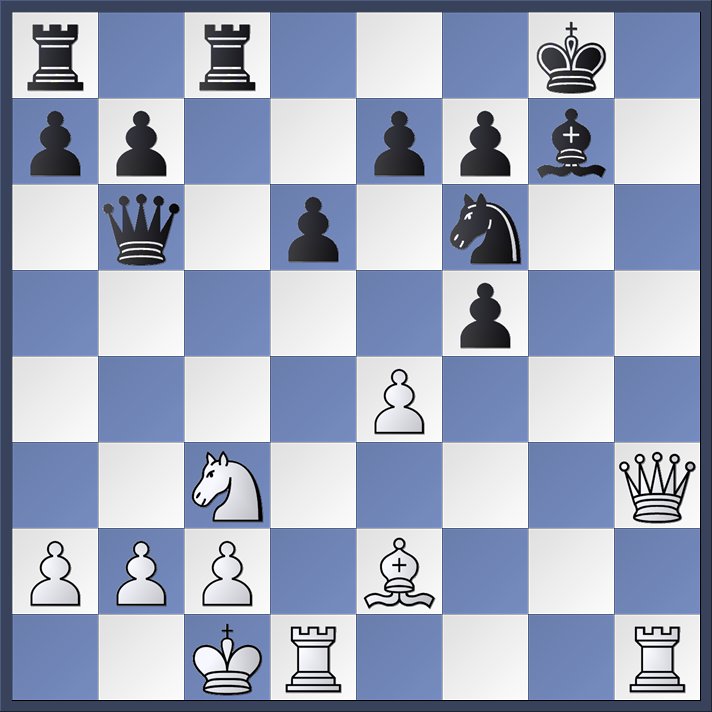
This came out of the always exciting Dragon Sicilian. Derrick, as black, played the thematic sacrifice 18. ... Rxc3!. Black gives up an exchange in return for busting up the pawns in front of the white king. After 19. bxc3 f4 20. Bf3 Qe3+ 21. Kb1 Qxc3 22. Rdg1, we come to my favorite move of the game:
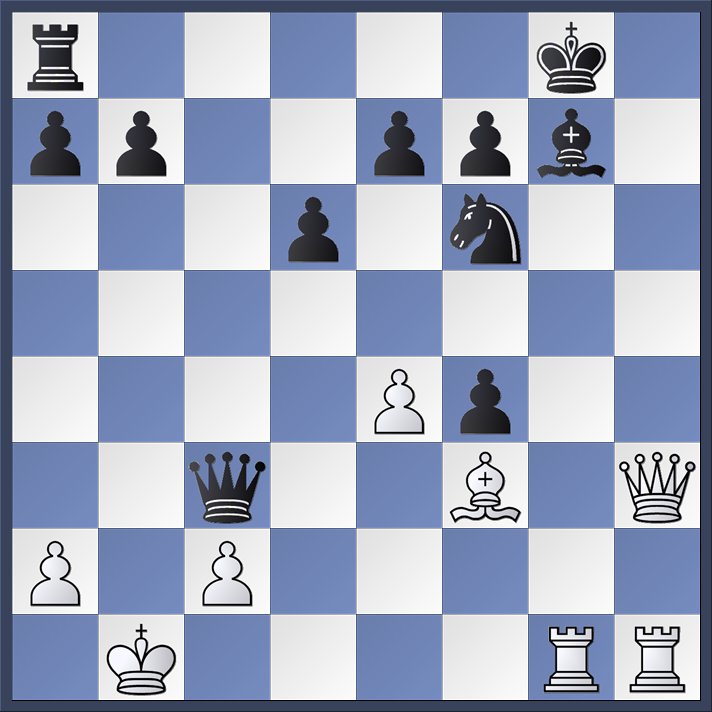
Both sides are going for glory, but destiny favors black. Derrick unleashed 22. ... Ng4, which has the obvious point of opening the line for the bishop on g7, thereby threatening mate on b2. It also has the less obvious, but thoroughly delightful point that it covers f2. A few moves from now that will prevent the white king from slipping the noose. White tried 23. Kc1 but that was just out of the frying pan and into the fire. Derrick now forced mate in nine, starting with: 23. ... Qe3+ 24. Kb1 Qb6+ 25. Kc1 Bb2+:
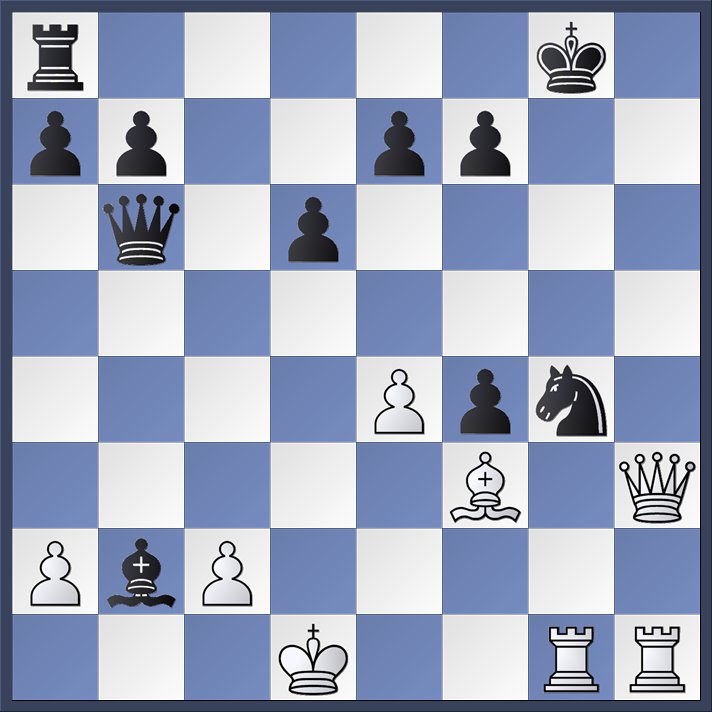
26. Kd1 Qd4+ 27. Ke2 Qe3+ 28. Kd1 Qc1+. The end is now in sight, but, sadly, we must now say a word about the asshole factor in chess. From here it is trivial to analyze the game out to a forced mate. Derrick's opponent surely saw what was about to happen. But instead of resigning, like an honorable player, or quickly playing it out to mate, he just sat there and watched his teammates games. Derrick's opponent had thirty minutes on his clock, and this nonsense went on for twenty of them. Then he played 29. Ke2 Qxc2+:
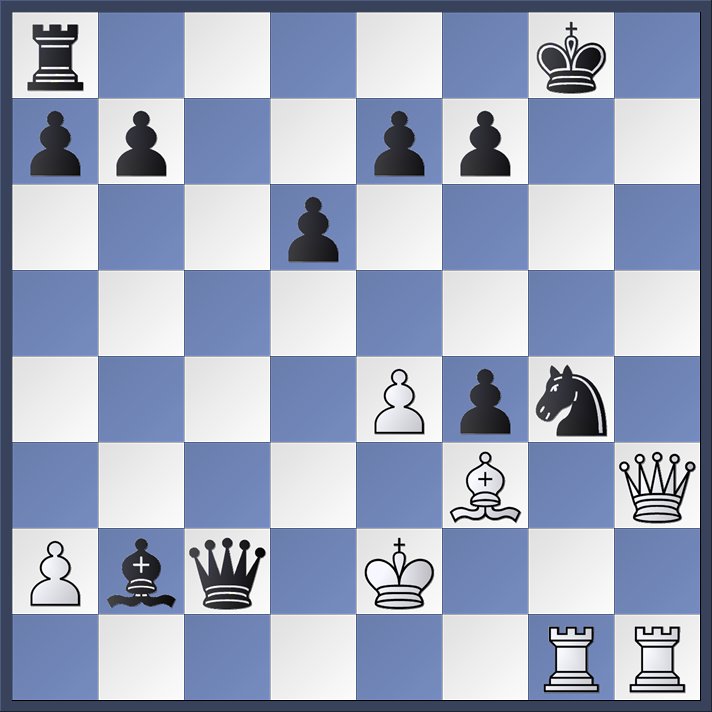
and rather than resign or play out the inevitable 30. Ke1 Bc3+ 31. Kf1 Qf2 mate, he just got up from the board and left. Derrick had to wait ten minutes for his opponent's flag too fall before claiming the win. Very dickish, and happily very rare.
With so many people there, it's inevitable that you are going to run into some old friends:
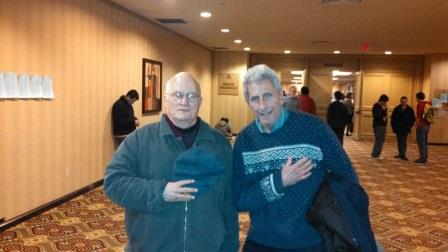
That's Curt on the left. Standing next to him is another fixture of the NJ chess scene, and a former club member, Clive Usiskin. It was great to see him again.
Round One didn't go so well for us, so we ended up paired way down for Round Two. This was the only round in the tournament in which I played someone lower rated than myself. Happily, he was rated way lower, and for most of the game he played like it. I was black this time, and played the Scandinavian Defense. After 24 moves I was just up two pawns. I was looking forward to converting my advantage into a full point. Then this happened:
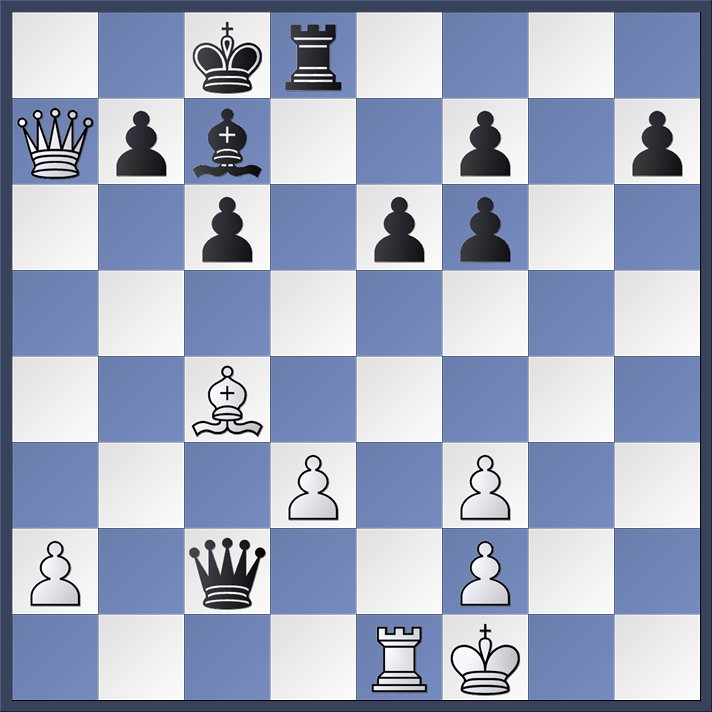
My bishop had been sitting on h2 for several moves (it was that kind of game), and since I was unable to come up with anything better I decided to bring it back to civilization while awaiting developments. So I thoughtlessly moved the bishop from h2 to c7. This turned out to be a real howler, since white now had the chance to show some tactical alertness. He played 25. Rxe6 fxe6 26. Bxe6+ Rd7 27. Qa8+ Bb8 28. Bxd7+ Kxd7 29. Qxb8:

Well, that was a fine how do you do. Sadly for white, it isn't enough. Black will just take the pawn on d3, and he holds all the trumps in the queen ending. My opponent made life easy for me by blundering his queen a few moves later.
Ned and I took care of business fairly quickly, but Curt and Doug preferred a more leisurely pace:

Did I mention there was a big ice sculpture?

Why was there an ice sculpture? Well, if you have to ask you'll never understand.
Our success in round two led to being paired way up in round three. I was playing white. Two moves in, this was the position:
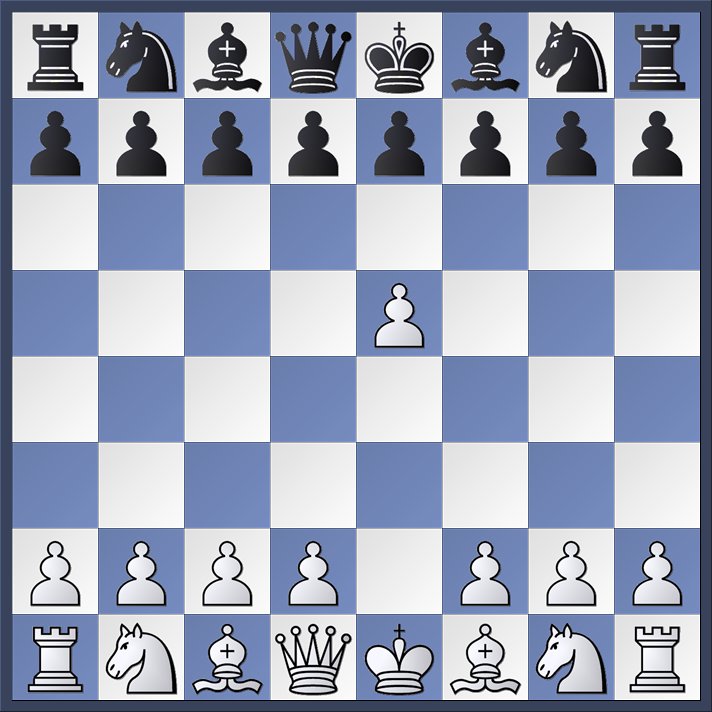
Seriously! The moves were 1. e4 Nf6 2. e5 Ng8. This is a very unusual line of the Alekhine Defense, sometimes referred to as the Brooklyn Variation. My initial reaction was that this is silly, but the more I think about it the more I like black's play. You can argue that black has lost time, but what exactly has white done with his extra two moves that is so valuable? Black has not introduced any weaknesses into his position, and white's pawn could well end up being weak. At any rate, if there is a slam dunk refutation of this line I didn't manage to find it. After 21 moves, this was the position:

The computer says white is only slightly worse, but I think this is the kind of position computers don't assess so well. During the game, perhaps intimidated by my opponent's very high rating and Russian name, I thought I was already close to lost. The problem is that white's bishop is really just a big pawn, his a and c pawns are weak, and the queenside white squares a4, b5 and c4 are just crying out for a black invasion. White, by contrast, must just defend passively. Perhaps a grandmaster could have held the position, but it proved too difficult for me. Let's fast forward to move 47, with black to move:
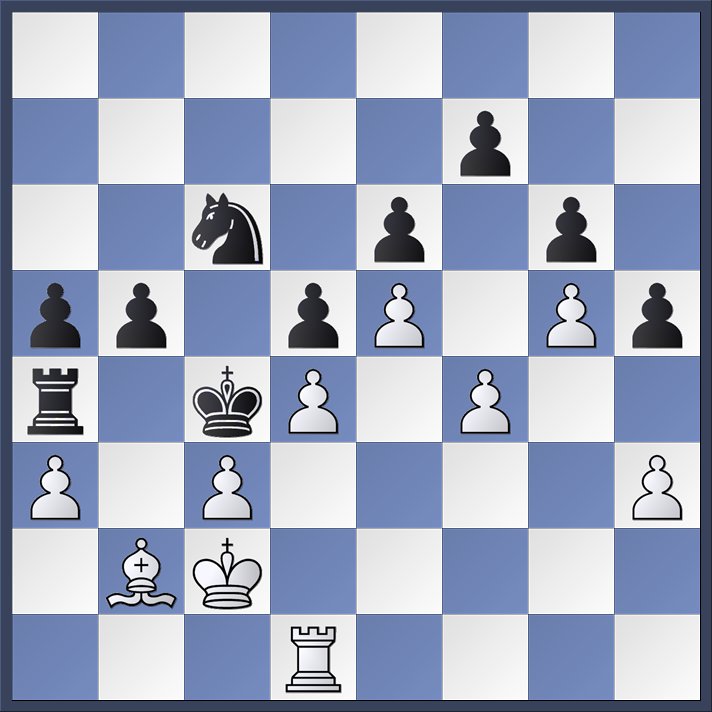
Black has gradually transferred all of his pieces to optimal squares, and he is now ready for his breakthrough. Play continued 47. ... b4 48. axb4 axb4 49. cxb4 Nxb4+ 50. Kb1 Nd3 51. Rd2 Rb4 52. Rc2+ Kb5:

Well, that takes care of that. Black will just trade all of the pieces on b2, after which the pawn ending is a trivial win. I resigned. Ouch!
That was the halfway point of the tournament, and so far I had not distinguished myself with any sort of decent play. Happily, that was about to change. The last three rounds saw three of the best tournament games I have ever played. I was paired against experts in every round, and managed two and a half points out of three.
I should have known things were looking up. Bill McNeal stopped by!

That's him on the right, with Ned, at a local Chinese restaurant. I'm sure you remember Bill from the comments on this post.
On the second day of the tournament, Curt selfishly put his nephew's weeding ahead of the team, leaving us down a man. Happily, the old Princeton Chess Club has a very deep bench, and Brian Cige filled in for the day. Alas, I never got around to snapping a picture. Sorry, Brian!
My path back to glory started in round four. USATE afficianados are aware that the fourth round begins with the voting for the best team name competition. Thanks to Doug, our team name was “The Winawer of our Discontent.”. We got nominated as one of the ten best names! Woo hoo! Sadly, we lost out to “Rg3! Offensive Rook of the Year.” I didn't get it either, but I think it's a reference to this guy.
Anyway, I sat down for the game. My opponent looked at me and said, “We played last year.” I raised an eyebrow, since I didn't remember the game. “You won,” he added, not smiling. I have a little notebook where I keep all my games, and I was quickly able to find the scoresheet from the previous year. I remembered the game as soon as I saw the sheet. Ah, yes, I was in fine form that day. More precisely, my opponent made a big blunder about twelve moves in and that was all she wrote. I didn't figure to get that lucky again, and he totally looked like he was out for blood.
The game started with a Reti Opening. That has a reputation for quiet play, but in this case everything was very intense and tactically complex. My opponent sacked a pawn for quite a lot of activity. I was playing black. Here was the position just before my 26th move:
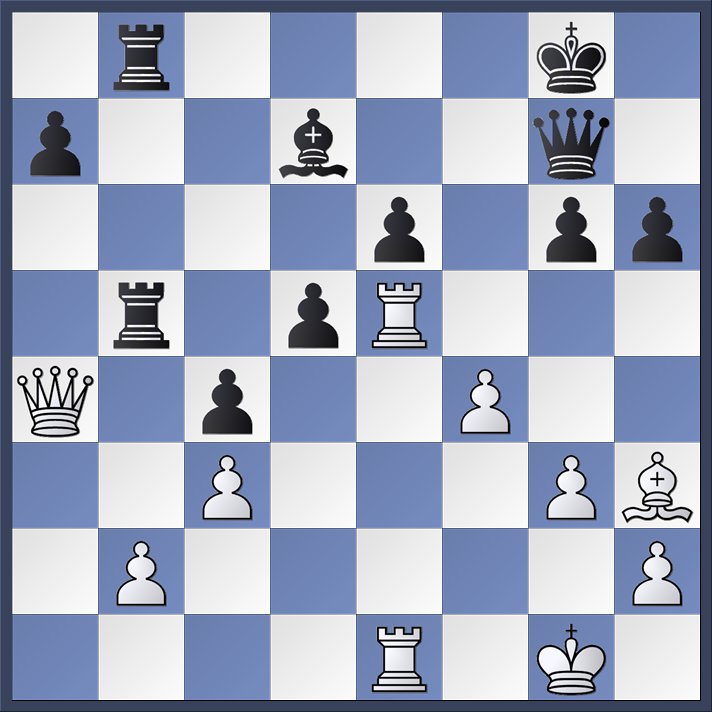
Oy! Black is up a pawn. He is obviously threatening to move his rook on b5, thereby discovering an attack on the white queen. But white has a threat of his own. He has just moved his bishop to h3, intending to take on e6 with check. After the bishop trade his rooks will come into black's position and personally explain to his king that he should have been paying more attention to defense. The white queen may look out of play on a4, but it is threatening to invade on e8. What to do?
Happily, I found a solution. Play continued: 26. ... Rxb2! 27. Bxe6+ Bxe6 28. Rxe6 Rb1 29. Re8+ Kh7 after which we have a very artistic arrangement of rooks:
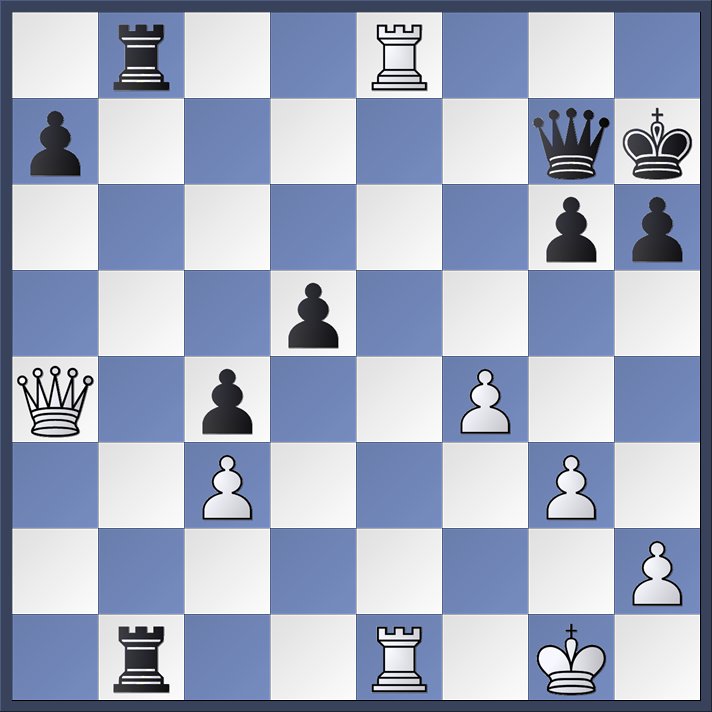
Objectively the position is about level, but white is the one who must be careful. He wasn't! Play went 30. Qc6 Rxe8 31. Rxb1 Re7 32. Qxd5 Qxc3:
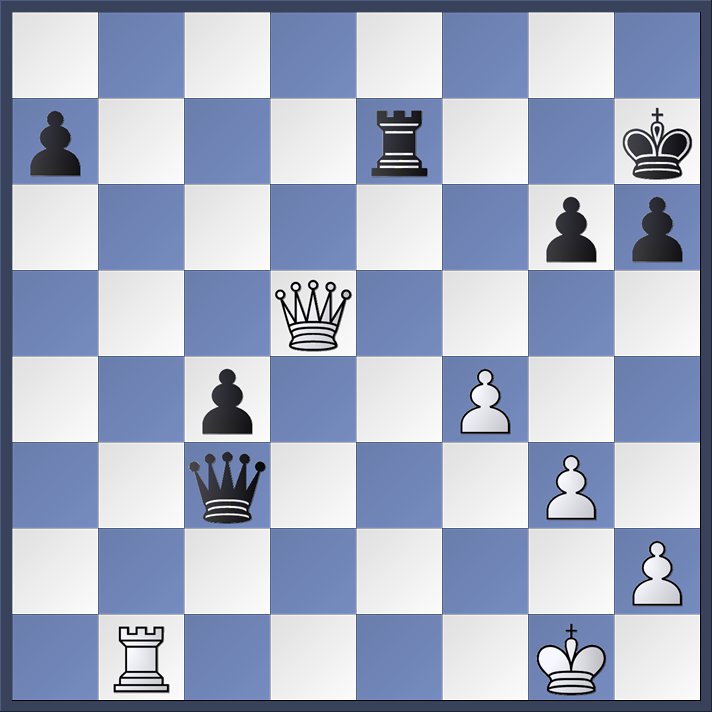
Now we have an instructive error. It was essential for white to play actively with 33. Rb8! Black would still be better, but this would definitely have kept white in the game. Instead he played the passive 33. Rd1, and after 33. ... Qe3+ 34. Kg2 c3 35. f5 c2, his position is hopeless. His flag fell as he grimly contemplated his hopelessness.
Have I mentioned that chess isn't just for people?

Have a look at this picture:

Behind the table we see another pair of chess celebrities. That's Steve Doyle and his wife, Bernadette. Steve is a legend in chess circles. In the eighties he was the President of the United States Chess Federation. He has been running this tournament for something like twenty years. Best of all, he is also a former member of the Princeton Chess Club! As it happens, Steve and Bernadette have a teenaged son who will be entering his senior year of high school in the fall. He is considering JMU as a possible college, so they will be visiting me here shortly. Yay!
Round five was at 9 am on Monday morning. Ugh! Making matters worse, my opponent was another fellow I played last year. Alas, in that game he blew me off the board. He is well known in NJ chess circles, and has a reputation for playing crazy, offbeat gambits. These are the sorts of openings that are often not quite sound, and will get you crushed if you spring them on a grandmaster, but which can be incredibly hard to figure out at the board. If your opponent has studied all the lines ahead of time, and you are making it up as you go along, you might be in for a long day at the office. I have to admit, I was a little afraid of the guy.
I was playing white, and once again went to my favorite Bishop's Opening. It wasn't long before my opponent sprang his surprise:
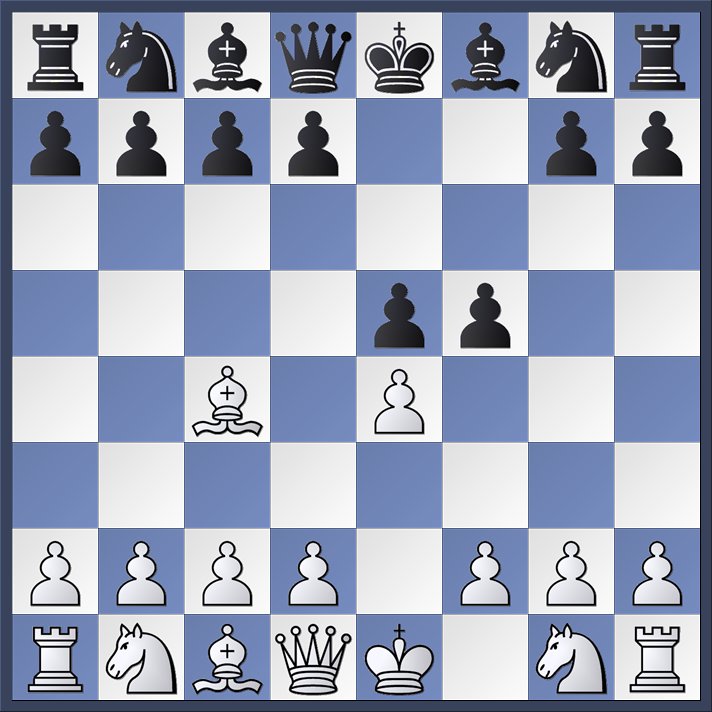
This, of course, is the Calabrese Countergambit. White has all sorts of responses. 3. d3 is safe and solid. 3. Nf3 is a bit more aggressive. 3. f4 looks deeply cool. But I tried, 3. d4 which is an old suggestion of the former World Correspondence Chess Champion Yakov Estrin. The move is playable, but I think not as strong as the alternatives. Anyway, here's the position just before black's ninth move:

My opening play has been less than brilliant. Black can probably claim a slight edge here. But he went seriously wrong with 9. ... Ne4? This walks right into a pin after 10. Bxe7 Qxe7. I played 11. c4!, after which black has some serious thinking to do.
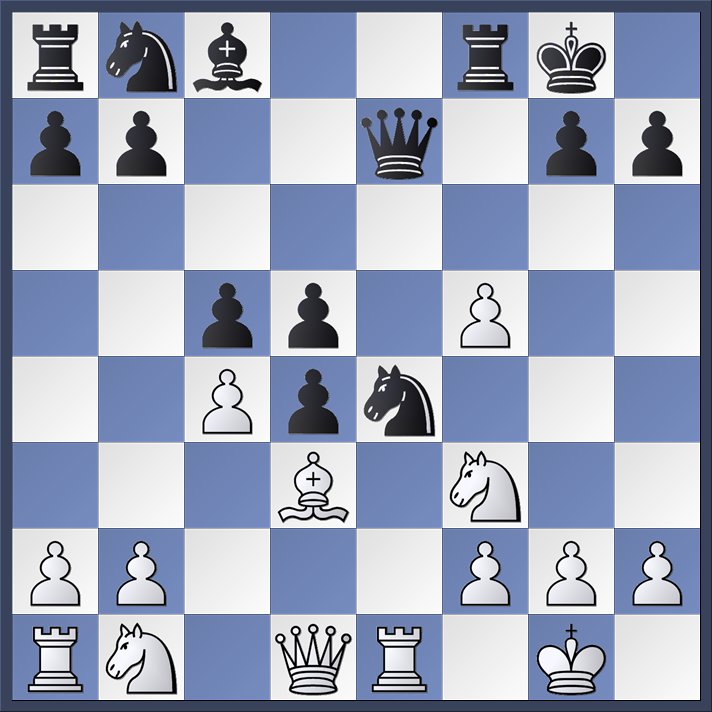
He went for 11. ... dxc3 e.p. 12. Nxc3 Nxc3. Here the computer says that Qb3 gives white a big advantage. But I played 13. Rxe7 Nxd1 14. Rxd1 Nc6 15. Rc7 instead. I was rather pleased with that little rook move, since I think black has some real problems to solve. I think he had to just take the pawn on f5 either here or on the next move, but instead play went, 15. ... Rb8 16. Bb5 d4:
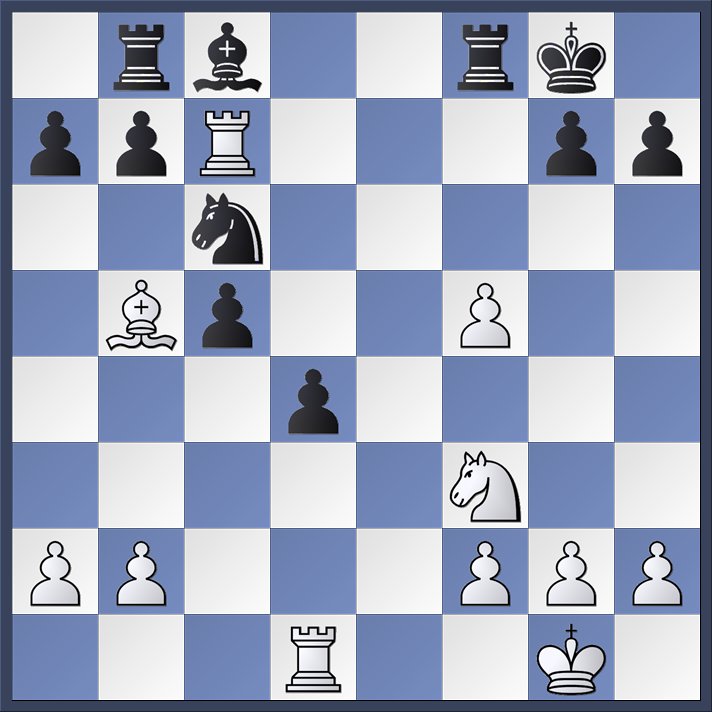
I played 17. g4!, and suddenly it's just game over. He is completely helpless against the slow motion threat of Re1, Bxc6 and Ree7. Seriously, how is he ever going to develop his queenside?
My opponent had mostly been moving very quickly, but now he slowed down dramatically and started shaking his head a lot. Play continued: 17. ... h6 18. Re1 Rd8 19. Bxc6 bxc6 20. Ree7 d3:
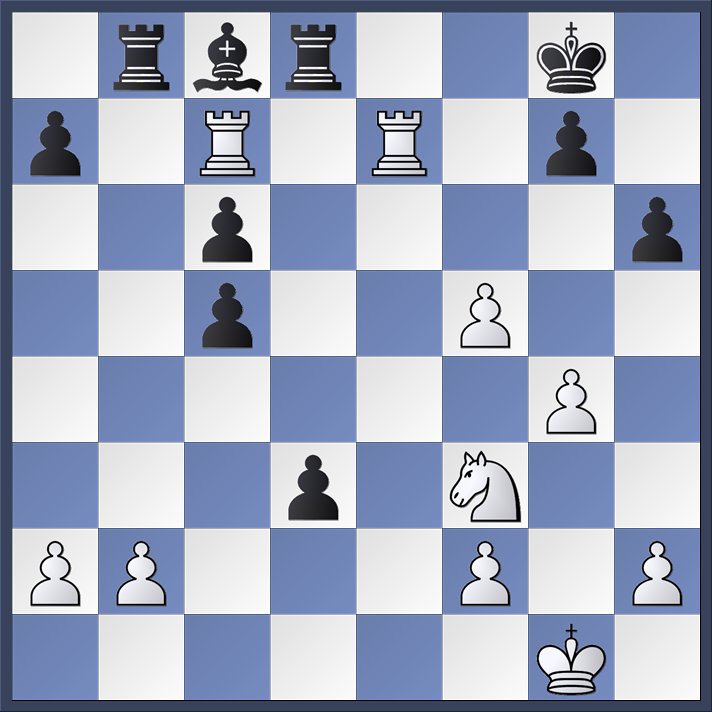
Black's position is pretty grim. All of his pieces are on the back rank, and his pawn structure looks like it has been eaten by moths. Time for the kill. It's forced mate after 21. Rxg7+ Kf8. Black could have held out a bit longer with Kh8, but it would not have made any real difference. 22. Rcf7+ Ke8 23. Ne5:

And now there's nothing left for black to do but wonder how it all went so wrong. He played it out with 23. ... Rb7 24. Rg8 mate. A satisfying revenge for what he did to me last year.
Meanwhile, here's Jon teaching his opponent a lesson about rook endgames:

That's the aforementioned Joel Heinrich next to him, in the baseball cap. Next time I'll try to get a picture of his face.
The time control was such that no game can take longer than six hours. At the amateur level, a majority of the games are over after four hours, and by five-hour mark the formerly packed ballroom is mostly empty. I always find it fun to walk through the ballroom to look at the games of the poor folks who are still playing. This time around I was rewarded with another Princeton Chess Club sighting:

The fellow on the left is former club member Andy Mishra! He now runs a club of his own down in Southern New Jersey. Alas, I caught him at a less than happy moment. He had lost his game in this round, and those kids are explaining to him what he did wrong.
There was just one more game to go. After a long tournament it can be hard to work up your enthusiasm for another game. A lot of teams simply withdraw and go home (which is fine, as long as you remember to tell the tournament director that you're leaving!) We decided to stick it out. I sat down across from a kid who was eye-level with the pieces. I asked him his rating. He said 2104. Great.
I was black and responded to his queen pawn opening with the Nimzo-Indian Defense. Play proceeded along normal lines. He definitely got an edge out of the opening and was able to put some pressure on me, but computer analysis confirms that he was never really in danger of breaking through. The most interesting part of the game occurred near the end:

White has just played his 39th move, Qf5+. Now there was an amusing double blunder. Had I played 39. ... Kg8 everything would have been fine. Instead I played the awful 39. ... Kg7. Of course, I saw that my knight on c5 was hanging. I wasn't worried about this, however, since after 40. Qxc5 Qxc5 41. Rxc5, black uses white's weak back rank to win back the piece with 41. ... Rxe3! White can't recapture because of the threat of Rd1 mate. Nor does it help matters to try 40. Rxc5 Qxf5 41. Rxf5, since black again just takes the knight on e3.
Have you noticed what I missed? Of course, after 40. Rxc5 Qxf5 white can play Nxf5+! Since black is now in check, he has no time to take the white rook on e1. That's why it was such a bad idea to put the king on g7. Chess is a tough game. I could try leaving out Qxf5, and just take on e3 immediately, but then white comes crashing through with Rc7+.
Fortunately, my opponent only had twenty seconds left to make his fortieth move. He banged out 40. Qc2, after which white is objectively lost after 40. ... Nd3, since he is about to lose serious material.

Had it been earlier in the tournament I would surely have played it out. But by now I was a bit flustered, since it suddenly dawned on me that I had just dodged a bullet. Moreover, with so many heavy pieces and an open position, it was clear there was plenty of hard work standing between black and his full point. With nothing riding on the game I decided I preferred to spend that time having dinner with my friends, so I simply offered a draw. My opponent gratefully accepted.
And that's it! A final tally of three wins, two draws and a loss. I will get a big pile of rating points for that little performance. But the real prize was getting to see all my old chess friends once again.
Apparently Gary Kasparov is going to be visiting the tournament next year. Guess I'll have to do a super mega epic blog post for that one!

Concerning that Dragon game I wanted to ask why not ...Nxe4 iso Ng4, but I'm not going to argue with forced mate.
The variation 1.e4 Nf6 2.e5 Ng8 gets a whopping four pages in Siebenhaar, Delnef and Ottstadt's Big Book on the Alekhine - out of 1200 pages in two volumes! Completists as they are they mention the stemgame Berwick-Edinburgh, corr. 1860/61, which means it's older than the opening itself. To paraphraze you: anyone who asks why this is relevant won't understand it anyway.
They also note that 3.d4 d6 4.exd6 Qxd6 is a position from the Scandinavian Defence. Probably best is 4.Nf3 when a game Smejkal-Vesely, Czechoslowakia 1968 went very well for White. The first player would become a GM, so we better take this seriously.
Obviously you traded the wrong pieces; that Bishop vs. Knight position is a horror.
Next time before you trot out 3.d4 against the Calabrese you better study the Falkbeer Counter Gambit or the Modern Defence of the King's Gambit. GM Bologan played it in 2011, so it can't be that bad.
"Kasparov is going"
Maybe I should contemplate a vacation to the US next year ... of course the main reason being that the tournament sounds like lots of fun.
Hey Jason, thanksfor the write-up!
Two points about your fried Derrick's Dragon game:
1. My first thought was why not ...Nxe4 rather than ...Ng4 also. A bit more thought and I realized maybe it's primary purpose is to prevent funny stuff along the g file (Rx g7+ in conjunction with Q h7).
2. The Dragon is of course a PERFECT opening for Black to bring to the table at the USATE, since the game will be over mostly within 2 hours leaving ample time for meals, kibitzing with buddies, and rooting around the bookstore.
Thx again. I'll be re-reading this one for sure.
In the Higgins game, I think Nxe4 for black would have run into an immediate Qh8 mate. White can take advantage of the pinned bishop. So, yes, Ng4 does prevent funny stuff down the g-file!
MNb --
Thanks for the commentary, especially about the Brooklyn Variation. I'm beginning to think that after 1. e4 Nf6, I should just play 2. Nc3.
Bill --
Whenever I play the Dragon as black, it seems like I just get mated on h7. But when I play against it as white, it seems like he always just sacs on c3 and mates me on the queenside. I guess this is why it's good to study the openings before the tournament. Maybe I'll just start playing the fianchetto line as white.
It was great to see you at the tournament.
lol ... but of course! Mate in one is always a bit tricky for me to find since it involves not sacrificing material :)
Btw playing 1.e4 Nf6 2.Nc3 contains good possibilities of winding up with a 4 Knights variation (2...e5 3.Nf3 Nc6), when you can cut down your expected game time by 4. d4 exd4 5.Nd5,offering the e-pawn to the courageous warrior opposite you. Lotsa fun, shaves off hours of strategic think time.